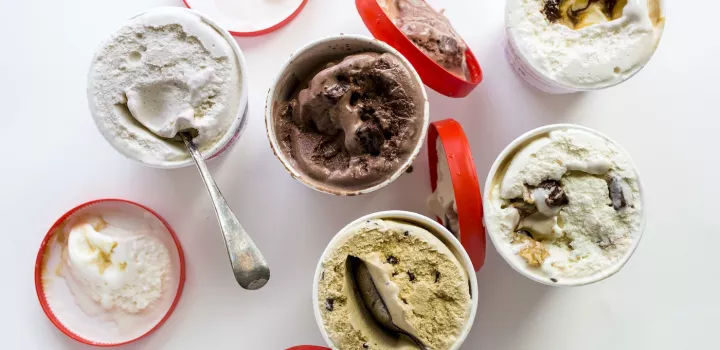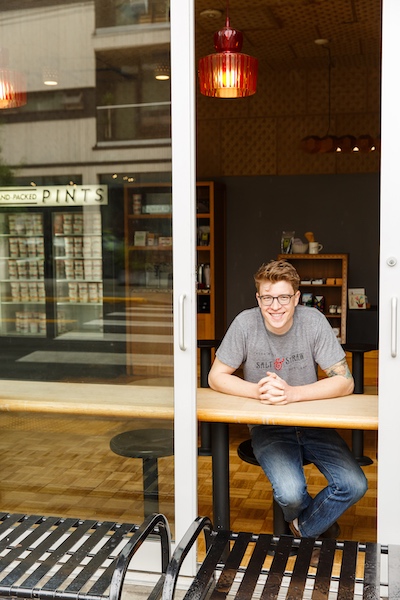
Salt & Straw’s Keys to Making Great Ice Cream
Hint: It’s in the Base
Since co-founding Salt & Straw with his cousin Kim Malek in 2011, Tyler Malek has developed more than 1,000 flavors as the company’s head ice cream maker. After launching the brand in Portland, Oregon, the duo went from selling eight flavors from a single pushcart to opening more than 20 locations up and down the West Coast.
Initially, Tyler developed the early flavors using an ice cream maker he found at Goodwill. Today, he designs the shop’s flavors (20% of which are vegan) in his research and development lab, introducing them to the public on the first Friday of every the month.

“We’re always thinking, what kind of journey do we want to take the customer through?” Tyler tells ICE students during an online demonstration. “If it’s not grounded in an overarching story that customers want to come in and hear, then it’s pointless and it comes off weird, instead of intriguing.” Case in point: This summer, Salt & Straw launched a camping series inspired by the great outdoors and campground snacks with flavors like buttermilk pancakes, bacon and eggs, salted hazelnut praline s’mores, and huckleberry cast iron corn bread. (Yes, please!)
Before the flavor brainstorming can even begin, the one constant starting point is a good ice cream base mix.
“Every pastry chef has their own ideas and theories on what a good ice cream base is,” Tyler says. “I can give you a little bit of the science into why I think mine is the best. A good ice cream base has a specific amount of fat, sugar, milk solids and water. Everything else is there to support it.”
Here's how Tyler makes a great base:
Fat
“You can choose any direction you want with fat, honestly. But, typically, you never want to go above 18%,” Tyler explains. “When I go even to fine-dining restaurants, that’s the number one mistake early pastry chefs make, they try to go too high into the fat. It’s tempting because you want to put so much fat in it — it feels like it would be better and more luxurious.” What results is the fat molecules cling together, forming little chunks of butter that coat the mouth. “From a customer perspective, your guests are going to notice almost like a little film on the back of their teeth.”
“If I’m doing a great fruit-based ice cream — strawberries can’t hold up against all that fat, so I’ll do more like a 12% fat. Or, maybe you want a pop of acidity, we might even take it down to an 8%, more like a gelato. Every category has its own positives and negatives, but as long as you’re staying between 0 and 18, you’ll be creating a really good product.”
Sugar
“Sugar is important for two reasons, but most people get this wrong,” Tyler warns. “The first thing people say: Sugar adds sweetness, and that’s great, but it’s actually more of a side benefit.” The most important role sugar plays in the ice cream process is its anti-freezing properties. “Water freezes at 32 F, but we serve our ice cream at 0 F,” he says. “That’s a huge difference. The only reason we can serve our ice cream at 0 F and still scoop through it beautifully is if we have a decent amount of antifreeze. And it just so happens that sugar is one of the most delicious antifreezes in the world.”
According to Tyler, a good ice cream base is typically 14-20% sugar. “I’ll go up to 20% sugar with our vegan recipes, and for our ice cream, I’ll go down to 14-17%.” Tyler uses three kinds of sugar for his ice cream base: tapioca syrup (he recommends organic corn syrup for home cooks), inverted sugar syrup and cane. “You want a dynamic set of sugars to starch,” he advises. “Having that combo of sugars will be really great and decrease the overall relative sweetness.”
Milk Solids
“The whole reason we add powdered milk (non-fat dry milk) is because milk solids are insanely important to good ice cream,” Tyler says. “It’s highly overlooked in most home kitchens, but it is the number one trick you can learn in making great ice cream — just add a couple tablespoons of dried milk.” The added benefit of milk powder is more structure and flavor.
Water
“The most important ingredient of them all, above and beyond, is water,” Tyler says. Ice cream must have at least 55% water or it won’t freeze. An ice cream with too much water can be icy and cheap tasting. “You need water because it is the only thing that actually freezes in your ice cream. Fat hardens, but it doesn’t necessarily freeze. Sugar never freezes."
“Milk is 94% water and cream is 55% water so we’re adding a lot of water in the form of milk or cream,” Tyler says as he demonstrates making a base, noting he never heats the cream, only the milk. “If your ice cream isn’t freezing up enough, put a couple splashes of water and it will harden up really nicely.”
“We have almost 20 different base recipes in our kitchen, depending on how much fat we want or sugar,” Tyler says of Salt & Straw. “At the end of the day, you need to start with something you know is going to freeze nicely. With this ice cream mix, we can make an infinite amount of ice cream flavors.”
Just remember, to “write it down so you remember what you did before,” Tyler points out on developing flavor recipes.
Study the science of professional-level desserts in Pastry & Baking Arts at ICE.


Add new comment